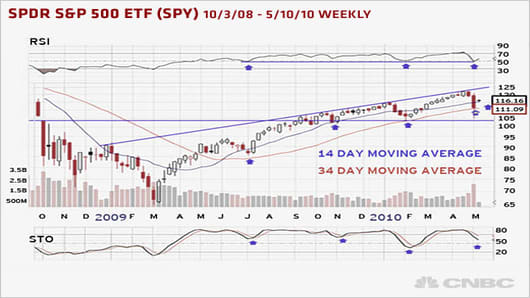In the S&P’s daily chart, three things stand out, Cramer said, “and they’re all negatives.” First, the biggest volume over the last month has been to the downside, which means those fund managers have been doing more selling than buying.
Second, notice at the top of the chart the relative strength index, or RSI, which measures how overbought or oversold a stock is. In this chart the relative strength of the S&P’s move up looks very weak because it was unable to break through the downtrend channel in the RSI. In technical analysis, that could mean the S&P stays oversold for a while without a snap back.
But “the ugliest thing of all about this chart,” Cramer said, is that the 14-day moving average of the S&P has just crossed below its 34-day moving average. That’s called a bearish crossover, and it means the index’s short-term trajectory is now worse than its more medium-term trajectory. That happened last in January, and it resulted in several weeks of rest for the S&P.
Early March saw a reverse, though, called a bullish crossover, where the 14-day moving average moved back above the 34-day. Then the S&P spent the next six weeks heading higher. Given that this pattern is time-tested, one of Cramer’s preferred chartists thinks that the 14-day now will act as resistance, meaning that over the short term he doesn’t see the SPY passing $118, or 1,180 for the S&P.


